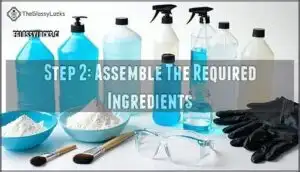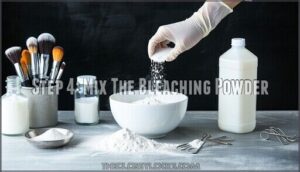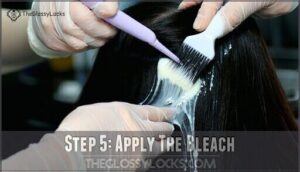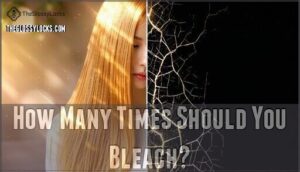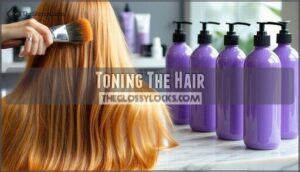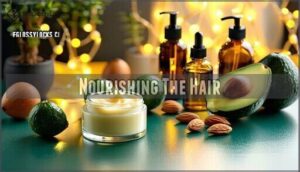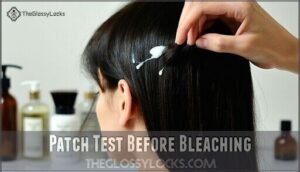This site is supported by our readers. We may earn a commission, at no cost to you, if you purchase through links.
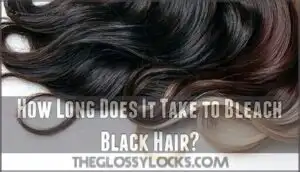
Going too fast is a recipe for breakage and fried ends. Think of it like climbing a ladder—you can’t skip rungs without falling. Each session lifts your hair a few levels lighter, and patience pays off with healthier results.
The real differentiator isn’t just timing but what happens before, during, and after each bleaching round.
Table Of Contents
- Key Takeaways
- Is Bleaching Black Hair Possible?
- How to Bleach Black Hair: 8 Steps
- How Long Does It Take to Bleach Black Hair?
- How Many Times Should You Bleach?
- Post-Bleaching Care
- At-Home Bleaching
- Hair Color, Texture, and Tone
- Patch Test Before Bleaching
- Do’s & Don’ts for Bleaching
- Frequently Asked Questions (FAQs)
- What products should I use to bleach my hair?
- How often should I bleach my hair?
- Is bleaching my hair bad for my scalp?
- Are there any natural methods for bleaching my hair?
- Is bleaching my hair at home safe?
- Can damaged hair be bleached safely?
- What causes orange tones after bleaching?
- How much does professional bleaching cost?
- Will bleaching cause permanent hair loss?
- Can you swim after bleaching black hair?
- Conclusion
Key Takeaways
- Bleaching black hair takes 30 to 60 minutes per session, but you’ll need two to four sessions spaced 2 to 4 weeks apart to safely lift dark pigment without causing breakage.
- Protecting your hair with coconut or olive oil before bleaching, dividing it into four sections, and never exceeding 30 minutes of processing time are essential steps to minimize damage.
- Post-bleach care is critical—use purple toners to neutralize orange and brassy tones, followed by deep conditioning masks and protein treatments to restore moisture and strength.
- Always perform a patch test 24 hours before bleaching to detect allergic reactions, and wait at least 4 to 6 weeks between sessions to allow your hair time to recover.
Is Bleaching Black Hair Possible?
While it might seem impossible to lift pitch-black hair to a lighter shade, all it really takes is a little know-how and the right plan.
You can bleach black hair successfully once you know what shape your hair is in, how much damage you’re willing to risk, and which bleach strength makes sense for your situation.
Whether you hire a pro or tackle it yourself, keep your expectations grounded—lightening black hair isn’t instant.
There’s always some trade-off, even with hair in great condition, so decide if the lighter look is worth the risk before you commit.
How to Bleach Black Hair: 8 Steps
Bleaching black hair takes careful steps for the best results. Here’s what you need to do, one step at a time.
Step 1: Apply Coconut Oil/Olive Oil
Right before you mix up that bleach, reach for coconut or olive oil and let your hair soak up some protection. This simple step builds a cushion, helping shield your strands from harsh chemicals—you’ll notice less breakage and dryness.
Go for coconut oil or olive oil, since both rank high for oil application benefits and work wonders overnight if you’re patient. Gently warm the oil for deeper penetration, or use a shower cap and low dryer heat for extra effect. Focus on roots, ends, and hairline, then wipe away excess oil or residue before starting.
Protective measures like gloves and petroleum jelly? Always smart.
Step 2: Assemble The Required Ingredients
Once your hair is good and coated with oil, it’s time to round up everything you’ll need before the real magic begins.
Here’s your must-have lineup:
- Bleach powder and hydrogen peroxide (or Bleach alternatives)
- Developer (pick a safe volume)
- Mixing bowls, application brushes
- Protective gear—gloves, goggles, petroleum jelly
Preparation prevents panic later!
Step 3: Divide Your Hair Into Four Sections
Think of this next part like prepping for a perfect paint job—splitting your hair into four sections makes the bleaching process so much smoother. It’s all about Sectioning Importance: when you divide your hair, you avoid tangles, control section size, and make even application possible.
Grab some clips or ties and secure each quadrant, working from back to front. When you approach it this way, every strand gets evenly coated with bleach—critical if you’re after salon-quality results.
Keeping your sections tidy also protects your hair, particularly when you’re planning multiple rounds on darker hair.
Step 4: Mix The Bleaching Powder
Before the magic happens, you need to get your bleach mixture just right. Pour your bleach powder into a non-metal bowl, then slowly add hydrogen peroxide or your chosen developer volume—getting the powder-to-developer ratio right is what keeps everything consistent.
Mix carefully with salon-safe utensils until you’ve got a smooth, creamy texture without any lumps.
- Measuring Accurately means brighter results
- Choose Mixing Utensils that won’t react with chemicals
- Avoiding Clumps gives you even lift
- Selecting your bleach and developer strength wisely ensures hair safety
Step 5: Apply The Bleach
Now that you’ve nailed the mix, it’s go-time—gloves on, brush in hand, and a deep breath as you start painting those first bold strokes.
Work fast, keeping sectioning tight so every strand gets Even Application. Begin at the ends and mid-lengths; leave Root Application for last.
Complete Bleach Saturation matters for black hair. Timing Starts now—watch your processing time closely!
How Long Does It Take to Bleach Black Hair?
What actually determines Bleach Processing Time for black hair? Your timeline depends on a few critical variables.
- Hair Thickness Impact—fine hair may lighten in 20 minutes, while coarse hair soaks up to 45.
- Desired Lift Level—going lighter means longer exposure, but even then, never exceed 30 minutes to avoid damage.
- Multiple sessions and careful Session Spacing are key for Damage Minimization.
To avoid damage and chemical burns, it’s important to take bleaching precautions. Bleaching black hair, especially at home, isn’t about speed—processing time requires patience and precision.
How Many Times Should You Bleach?
How many times should you reach for the bleach? The answer isn’t just in the bottle—it’s written in your hair’s history and your color ambitions. Chasing that platinum transformation calls for multiple sessions, but here’s the real talk:
- Overdoing it? That’s a shortcut to hair breakage and lasting damage.
- Stretch bleach session frequency: Pro stylists swear by eight-week recovery gaps.
- Desired shade level changes everything. Going from black to icy blonde? Expect two to four rounds—minimum—for safe, even hair lightening.
To avoid brassy tones, toning after bleaching is essential.
Assess, plan, and lighten with intention.
Post-Bleaching Care
Caring for your hair after bleaching is just as important as the process itself. Here’s what you need to keep in mind next.
Toning The Hair
Ever wondered why freshly bleached hair sometimes looks more orange than blonde? That’s where toning steps in. The right toner selection matters—purple toners target brassiness and orange tones for a cleaner finish.
Want even longer tone longevity? Reach for a purple shampoo to extend results between touch-ups. Application techniques vary, but always use purple formulas as directed for effective brassiness control.
Nourishing The Hair
Think your work is done after bleaching? Not quite. Your hair needs some serious recovery time to regain its strength and shine. Here’s what actually works:
- Deep Conditioning masks for hair moisture and repair
- Protein Treatments to reduce brittleness
- Hydration Methods like overnight oil treatments
- Fuel with a healthy diet—what you eat helps reverse hair damage, too.
At-Home Bleaching
Bleaching your hair at home can feel intimidating, but being prepared makes a world of difference.
Here’s what you’ll need to get started and stay safe along the way.
Required Tools
A good toolkit can make all the difference when you’re aiming to lighten black hair at home. Gather a bleach bowl, sturdy application brush, and quality protective gloves—don’t take shortcuts here. You’ll also need bleach powder and the right developer (like hydrogen peroxide) to nail the mixing ratio. Sectioning clips help you keep track as you work.
Thinking about a home dye kit? Make sure it includes everything, right down to a plastic cape for your shoulders and thorough instructions.
Safety Precautions
You’ve got your toolkit ready, but before you mix a drop, let’s talk about how to keep your hair—and yourself—safe in the process. Start with a patch test, the best practice for allergy prevention, even if you’ve bleached before. High product quality matters, so skip the off-brand stuff.
Always wear gloves—think of them as your first defense against “uh-oh” moments. Protective measures go beyond your hands: shield your eyes, cover your counters, and take it slow. Avoid overlap when re-applying bleach to already-lightened hair; that’s a shortcut to breakage and regret.
Build in recovery time between bleaching sessions so your hair doesn’t go from ambitious to fragile. And if you’re second-guessing, explore alternative methods for lightening. At-home bleaching safety isn’t about fear—it’s about staying radiant, not brittle.
Hair Color, Texture, and Tone
Before you even reach for the gloves, take time to understand your own hair color, texture, and tone. Every head tells a different story—black hair can hide red or orange tones that appear mid-process, while certain ethnic variations impact how deep your shade really goes. Expect some texture alteration: bleached strands can feel coarser or lose their curl pattern.
Consider these five realities:
- Hidden hair undertones
- Texture changes
- Variations by ethnicity
- Altered hair tone
- Lasting bleach damage
Patch Test Before Bleaching
Once you’ve wrapped your head around your hair’s quirks, it’s time to play it safe and check how your skin reacts to the bleach before you go any further. This patch test is your personal insurance policy—it confirms sensitivity and catches potential allergic reactions before they wreck your whole head. Mix a tiny amount of your bleach formula and dab it behind your ear or on your inner elbow. Wait 24 hours and watch for redness, itching, or swelling—these are red flags telling you to stop.
Beyond the allergy check, this quick test shows you whether the product will actually work for your hair and gives you a sneak peek at how much lift you’ll get when you bleach.
| Test Type | Purpose |
|---|---|
| Patch test | Allergy detection and skin reaction monitoring |
| Strand test | Checks color lift and processing time |
| Second check | Sensitivity confirmation for at-home bleaching safety |
Do’s & Don’ts for Bleaching
Before you grab that bleach bottle, let’s talk about what you should—and absolutely shouldn’t—do during the process.
Follow these tips to get great results without trashing your hair.
Top 4 Do’s
Bleaching black hair isn’t a gamble you want to lose—knowing what to do beforehand can save your strands from serious damage. Start with a thorough hair assessment to check for breakage or dryness. If your hair’s already compromised, hold off and deep condition for a few weeks first.
Always invest in quality products designed for dark hair—cheap bleach won’t cut it when you’re lifting multiple levels. Before you commit, run a strand test to see how your hair reacts and monitor progress every five to ten minutes during the actual bleaching process. This prevents overprocessing and keeps you in control.
Apply coconut oil or olive oil beforehand to shield your strands from harsh chemicals. Following these preparing hair for bleaching steps and bleaching hair dos and don’ts ensures at-home bleaching safety while helping you achieve the blonde tone you’re after without sacrificing hair health.
Top 3 Don’ts
When bleaching black hair goes wrong, it’s usually because someone skipped a key "don’t"—and these three mistakes can wreck your results faster than you can say orange disaster.
First, never skip the patch test—chemical damage from unqualified bleach products can trigger serious reactions. Second, don’t ignore existing damage or rush the process by overlapping bleach on previously treated sections. Third, avoid leaving bleach on longer than 30 minutes, as this compromises hair structure and accelerates breakage.
Stick to these basics and you’ll dodge most at-home bleaching disasters—keeping your hair intact instead of ending up with chemical burns or a crispy, broken mess.
Frequently Asked Questions (FAQs)
What products should I use to bleach my hair?
To bleach black hair effectively, you’ll need three core products: bleach powder, hydrogen peroxide (your developer), and protective coconut oil. Developer volume matters—20 or 30 volume works best for dark hair.
Don’t forget toner selection, protein treatments, and purple shampoo for post-bleach care.
How often should I bleach my hair?
Think of your hair like a marathon runner—it needs serious recovery time between races. You should wait at least 4 to 6 weeks between bleaching sessions when bleaching black hair, as multiple sessions stress hair health.
A hair elasticity test and damage level assessment help determine if your strands can handle another round, or if alternative coloring methods make more sense.
Is bleaching my hair bad for my scalp?
Yes, the chemical process can irritate your scalp and trigger product allergies or chemical burns if mishandled.
Protect yourself with gloves and do a patch test first—scalp sensitivity varies widely, and skipping precautions invites long-term effects like hair dryness, brittleness, and compromised hair health.
Are there any natural methods for bleaching my hair?
Natural lightening methods like chamomile tea, lemon juice, honey, or cinnamon offer DIY alternatives for gradual bleaching without harsh chemicals.
These herbal remedies and gentle options can brighten your hair over time, though they won’t dramatically lighten black hair like professional treatments would.
Is bleaching my hair at home safe?
With proper preparation, at-home bleaching can work—but it’s not without Home Bleach Risks. Product Quality matters, and so does Application Accuracy.
Use coconut oil beforehand, do a patch test, and follow instructions to minimize Hair damage. DIY bleaching requires vigilance for Damage Control, or consider Professional Alternatives.
Can damaged hair be bleached safely?
If your hair shows signs of damage—brittleness, breakage, or split ends from previous chemical treatments—hold off on DIY bleaching.
When hair is already compromised, its structure becomes more porous and the protective outer layer weakens. At that point, bleach can strip away essential proteins and cause damage you can’t reverse.
What causes orange tones after bleaching?
Orange tones aren’t a mistake—they’re actually Underlying Pigment revealing itself as bleach strips melanin from your hair. Black hair contains red and orange pigments that surface when Processing Time is too short, Bleach Strength is too weak, or Hair Porosity prevents even lifting.
Toner Selection is essential for neutralizing brassiness.
How much does professional bleaching cost?
Professional hair bleaching usually runs $150 to $400 per session. Salon pricing factors include your hair colorist’s experience level, bleach product quality, and location cost impact.
Maintenance cost considerations add up—expect multiple visits for black hair transformation.
Will bleaching cause permanent hair loss?
Good news—properly done bleaching won’t cause permanent hair loss or Alopecia. However, severe scalp sensitivity and Hair Follicle Damage from Bleach Side Effects can lead to temporary shedding.
Irreversible Hair Loss occurs only from extreme misuse causing brittle strands beyond hair damage repair.
Can you swim after bleaching black hair?
Jumping into the pool right after bleaching? That’s like inviting disaster to your freshly lightened locks. Wait at least 72 hours before swimming.
Chlorine and saltwater strip color, increase hair brittleness, and worsen damage. Use leave-in conditioners and protective swim caps to shield your hair’s health.
Conclusion
Think of bleaching black hair like peeling an onion—you need patience to remove each layer without tears. Now you know how long it takes to bleach black hair: 30 to 60 minutes per session, spread across multiple rounds.
Take your time, protect your strands between sessions, and don’t skip the deep conditioning. Rushing leads to damage, but a steady approach gets you to your dream color with hair that’s still healthy and strong.


